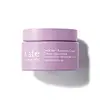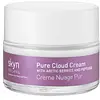What's inside
What's inside
 Key Ingredients
Key Ingredients

 Benefits
Benefits

 Concerns
Concerns

 Ingredients Side-by-side
Ingredients Side-by-side

Water
Skin ConditioningGlycerin
HumectantTrimethylolpropane Tricaprylate/Tricaprate
EmollientPentaerythrityl Tetraisostearate
EmollientCoco-Caprylate/Caprate
EmollientPentaerythrityl Distearate
EmulsifyingCetearyl Alcohol
EmollientCaprylic/Capric Triglyceride
MaskingBis-Stearyl Dimethicone
EmollientPropanediol
SolventButyrospermum Parkii Butter
Skin ConditioningPentylene Glycol
Skin ConditioningHexyldecanol
EmollientGlyceryl Stearate
EmollientDimethicone
EmollientCeramide NP
Skin ConditioningMel
EmollientTetrapeptide-14
Skin ConditioningCeramide EOP
Skin ConditioningBoswellia Serrata Extract
Skin ConditioningPhytosphingosine
Skin ConditioningCeramide AP
Skin ConditioningCholesterol
EmollientCamellia Sinensis Leaf Extract
AntimicrobialGlycine Soja Seed Extract
Skin ConditioningOryza Sativa Bran Extract
Skin ConditioningEctoin
Skin ConditioningCetylhydroxyproline Palmitamide
Skin ConditioningBisabolol
MaskingCucumis Sativus Seed Oil
EmollientHydroxyectoin
BufferingHelianthus Annuus Seed Oil
EmollientAdenosine
Skin ConditioningTasmannia Lanceolata Fruit/Leaf Extract
AntioxidantSorbitan Isostearate
EmulsifyingStearic Acid
CleansingBrassica Campestris Sterols
EmollientTocopherol
AntioxidantRosmarinus Officinalis Leaf Extract
AntimicrobialZingiber Officinale Root Extract
MaskingAspalathus Linearis Extract
Skin ConditioningAminomethyl Propanol
BufferingHydroxyphenyl Propamidobenzoic Acid
Skin Conditioning1,2-Hexanediol
Skin ConditioningPEG-40 Stearate
EmulsifyingHydroxyethyl Acrylate/Sodium Acryloyldimethyl Taurate Copolymer
Emulsion StabilisingButylene Glycol
Humectant4-T-Butylcyclohexanol
MaskingIsohexadecane
EmollientPolysilicone-11
Ceteareth-20
CleansingSodium Lauroyl Lactylate
EmulsifyingCaprylhydroxamic Acid
Xanthan Gum
EmulsifyingPolysorbate 60
EmulsifyingTrisodium Ethylenediamine Disuccinate
Carbomer
Emulsion StabilisingCitric Acid
BufferingPhenoxyethanol
PreservativeSodium Benzoate
MaskingPotassium Sorbate
PreservativeWater, Glycerin, Trimethylolpropane Tricaprylate/Tricaprate, Pentaerythrityl Tetraisostearate, Coco-Caprylate/Caprate, Pentaerythrityl Distearate, Cetearyl Alcohol, Caprylic/Capric Triglyceride, Bis-Stearyl Dimethicone, Propanediol, Butyrospermum Parkii Butter, Pentylene Glycol, Hexyldecanol, Glyceryl Stearate, Dimethicone, Ceramide NP, Mel, Tetrapeptide-14, Ceramide EOP, Boswellia Serrata Extract, Phytosphingosine, Ceramide AP, Cholesterol, Camellia Sinensis Leaf Extract, Glycine Soja Seed Extract, Oryza Sativa Bran Extract, Ectoin, Cetylhydroxyproline Palmitamide, Bisabolol, Cucumis Sativus Seed Oil, Hydroxyectoin, Helianthus Annuus Seed Oil, Adenosine, Tasmannia Lanceolata Fruit/Leaf Extract, Sorbitan Isostearate, Stearic Acid, Brassica Campestris Sterols, Tocopherol, Rosmarinus Officinalis Leaf Extract, Zingiber Officinale Root Extract, Aspalathus Linearis Extract, Aminomethyl Propanol, Hydroxyphenyl Propamidobenzoic Acid, 1,2-Hexanediol, PEG-40 Stearate, Hydroxyethyl Acrylate/Sodium Acryloyldimethyl Taurate Copolymer, Butylene Glycol, 4-T-Butylcyclohexanol, Isohexadecane, Polysilicone-11, Ceteareth-20, Sodium Lauroyl Lactylate, Caprylhydroxamic Acid, Xanthan Gum, Polysorbate 60, Trisodium Ethylenediamine Disuccinate, Carbomer, Citric Acid, Phenoxyethanol, Sodium Benzoate, Potassium Sorbate
Water
Skin ConditioningHydrogenated Didecene
Skin ConditioningButylene Glycol
HumectantGlyceryl Stearate
EmollientBisabolol
MaskingPrunus Amygdalus Dulcis Oil
Skin ConditioningSodium Hyaluronate
HumectantHydrolyzed Rice Protein
Skin ConditioningAngelica Archangelica Root Water
Skin ConditioningAcetyl Dipeptide-1 Cetyl Ester
Skin ConditioningLeuconostoc/Radish Root Ferment Filtrate
AntimicrobialCamellia Oleifera Leaf Extract
AstringentGlycerin
HumectantGlyceryl Caprylate
EmollientRubus Chamaemorus Seed Oil
Skin ConditioningSimmondsia Chinensis Seed Oil
EmollientAcrylates/C10-30 Alkyl Acrylate Crosspolymer
Emulsion StabilisingCanola Oil
EmollientCetyl Alcohol
EmollientCetyl Ricinoleate
EmollientSorbitan Stearate
EmulsifyingStearic Acid
CleansingCitrus Grandis Peel Oil
MaskingTriceteareth-4 Phosphate
EmulsifyingSilica
AbrasiveZea Mays Starch
AbsorbentGlyceryl Undecylenate
EmollientLaureth-3
EmulsifyingSodium Hydroxide
BufferingAloe Barbadensis Leaf Juice
Skin ConditioningHydroxyethylcellulose
Emulsion StabilisingPerfluorodecalin
Skin ConditioningPotassium Sorbate
PreservativeSodium Polyacrylate
AbsorbentEthylhexyl Stearate
EmollientSodium Benzoate
MaskingBuddleja Davidii Extract
Skin ConditioningGlycosphingolipids
EmollientSucrose Palmitate
EmollientThymus Vulgaris Flower/Leaf Extract
MaskingTrideceth-6
EmulsifyingXanthan Gum
EmulsifyingBiotin
AntiseborrhoeicWater, Hydrogenated Didecene, Butylene Glycol, Glyceryl Stearate, Bisabolol, Prunus Amygdalus Dulcis Oil, Sodium Hyaluronate, Hydrolyzed Rice Protein, Angelica Archangelica Root Water, Acetyl Dipeptide-1 Cetyl Ester, Leuconostoc/Radish Root Ferment Filtrate, Camellia Oleifera Leaf Extract, Glycerin, Glyceryl Caprylate, Rubus Chamaemorus Seed Oil, Simmondsia Chinensis Seed Oil, Acrylates/C10-30 Alkyl Acrylate Crosspolymer, Canola Oil, Cetyl Alcohol, Cetyl Ricinoleate, Sorbitan Stearate, Stearic Acid, Citrus Grandis Peel Oil, Triceteareth-4 Phosphate, Silica, Zea Mays Starch, Glyceryl Undecylenate, Laureth-3, Sodium Hydroxide, Aloe Barbadensis Leaf Juice, Hydroxyethylcellulose, Perfluorodecalin, Potassium Sorbate, Sodium Polyacrylate, Ethylhexyl Stearate, Sodium Benzoate, Buddleja Davidii Extract, Glycosphingolipids, Sucrose Palmitate, Thymus Vulgaris Flower/Leaf Extract, Trideceth-6, Xanthan Gum, Biotin
 Reviews
Reviews

Ingredients Explained
These ingredients are found in both products.
Ingredients higher up in an ingredient list are typically present in a larger amount.
Bisabolol is famous for its skin soothing properties. It does this by blocking inflammatory signals, helping to reduce your body's reaction to irritation.
This ingredient also interferes with the process of hyperpigmentation. This can help with reducing dark spots and uneven tone.
Bisabolol is an antioxidant. Antioxidants help fight free-radicals. Free-radicals are molecules that may damage your skin cells. By fighting these free-radicals, Bisabolol may slow down signs of aging.
Studies have shown Bisabolol to have antimicrobial properties and may be a fungicide. These properties help preserve a product's shelf life.
All these properties makes bisabolol a great skin barrier helper ingredient.
Bisabolol also helps the absorption of other ingredients.
Note: Synthetic Bisabolol has been shown to be less effective.
Learn more about BisabololButylene Glycol (or BG) is used within cosmetic products for a few different reasons:
Overall, Butylene Glycol is a safe and well-rounded ingredient that works well with other ingredients.
Though this ingredient works well with most skin types, some people with sensitive skin may experience a reaction such as allergic rashes, closed comedones, or itchiness.
Learn more about Butylene GlycolGlycerin is already naturally found in your skin. It helps moisturize and protect your skin.
A study from 2016 found glycerin to be more effective as a humectant than AHAs and hyaluronic acid.
As a humectant, it helps the skin stay hydrated by pulling moisture to your skin. The low molecular weight of glycerin allows it to pull moisture into the deeper layers of your skin.
Hydrated skin improves your skin barrier; Your skin barrier helps protect against irritants and bacteria.
Glycerin has also been found to have antimicrobial and antiviral properties. Due to these properties, glycerin is often used in wound and burn treatments.
In cosmetics, glycerin is usually derived from plants such as soybean or palm. However, it can also be sourced from animals, such as tallow or animal fat.
This ingredient is organic, colorless, odorless, and non-toxic.
Glycerin is the name for this ingredient in American English. British English uses Glycerol/Glycerine.
Learn more about GlycerinGlyceryl Stearate is a mix of glycerin and stearic acid.
It is used to stabilize the mixing of water and oil ingredients. By preventing these ingredients from separating, it can help elongate shelf life. It can also help thicken the product's texture.
As an emollient, it helps soften skin and supports barrier-replenishing ingredients.
In cosmetics, Glyceryl Stearate is often made from vegetable oils or synthetically produced.
This ingredient may not be fungal-acne safe
Fun fact: The human body also creates Glyceryl Stearate naturally.
Learn more about Glyceryl StearatePotassium Sorbate is a preservative used to prevent yeast and mold in products. It is commonly found in both cosmetic and food products.
This ingredient comes from potassium salt derived from sorbic acid. Sorbic acid is a natural antibiotic and effective against fungus.
Both potassium sorbate and sorbic acid can be found in baked goods, cheeses, dried meats, dried fruit, ice cream, pickles, wine, yogurt, and more.
You'll often find this ingredient used with other preservatives.
Learn more about Potassium SorbateSodium Benzoate is a preservative. It's used in both cosmetic and food products to inhibit the growth of mold and bacteria. It is typically produced synthetically.
Both the US FDA and EU Health Committee have approved the use of sodium benzoate. In the US, levels of 0.1% (of the total product) are allowed.
Sodium benzoate works as a preservative by inhibiting the growth of bacteria inside of cells. It prevents the cell from fermenting a type of sugar using an enzyme called phosphofructokinase.
It is the salt of benzoic acid. Foods containing sodium benzoate include soda, salad dressings, condiments, fruit juices, wines, and snack foods.
Studies for using ascorbic acid and sodium benzoate in cosmetics are lacking, especially in skincare routines with multiple steps.
We always recommend speaking with a professional, such as a dermatologist, if you have any concerns.
Learn more about Sodium BenzoateStearic Acid is a fatty acid. It is an emollient, emulsifier, and texture enhancer.
As an emollient, stearic acid helps soften skin. It aids the skin's protective barrier by preventing water loss. It also provides a gentle cleansing effect without stripping away natural oils.
Stearic acid may also be used to enhance the texture of products. It can add volume and stabilize ingredients such as water and oil. This can help water and oil ingredients from separating.
Sources of stearic acid include animal or vegetable fats/oils such as coconut or shea. It can be naturally found in butter, cocoa butter, shea butter, vegetable fats, and animal tallow.
This ingredient may not be Malassezia folliculitis, or fungal-acne safe.
Learn more about Stearic AcidWater. It's the most common cosmetic ingredient of all. You'll usually see it at the top of ingredient lists, meaning that it makes up the largest part of the product.
So why is it so popular? Water most often acts as a solvent - this means that it helps dissolve other ingredients into the formulation.
You'll also recognize water as that liquid we all need to stay alive. If you see this, drink a glass of water. Stay hydrated!
Learn more about WaterXanthan gum is used as a stabilizer and thickener within cosmetic products. It helps give products a sticky, thick feeling - preventing them from being too runny.
On the technical side of things, xanthan gum is a polysaccharide - a combination consisting of multiple sugar molecules bonded together.
Xanthan gum is a pretty common and great ingredient. It is a natural, non-toxic, non-irritating ingredient that is also commonly used in food products.
Learn more about Xanthan Gum